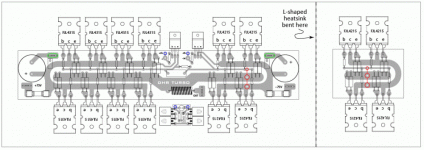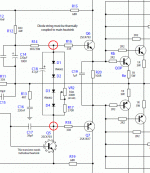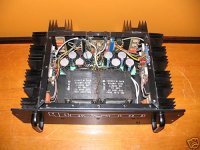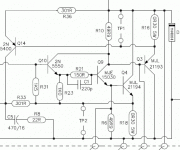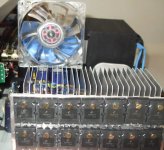Depending how good (big) are your heatsinks it will hold 150 percent power
Along all nigth... was tested to survive such kind of heavy duty work. (this is around 3 percent distortion... and a lot of folks do not perceive this as bad sound..some folks thinks this is just "loud")
And 150% power into this beast is a lot of power... the speakers may not survive or the party folks ears will be damaged in advance this amplifier will shut down.
Was tested during one hour long...2 ohms load... around 800 watts of power (supply loose voltage) with big fan blowing air over enormous heatsink...environment temperature was 29 degrées celsius)...if survived this way..... into your Romanian winter you gonna have it working in a very confortable way.
Lovely for powerholics... reliable..... will make them happy melting speaker coils and producing cracks into home walls.... it uses to bother cocoroaches (roaches) that do not like too much vibrations and also will bother mouse... as can amplify the 40 Kilohertz sound bad filtered from the audio source..some CD players have not very well filtered high frequencies...mouse hate that frequencies..... can be lovely to people that has bad circulation and needs some massage into the legs... low frequency power will vibrate your floor... that vibration will be transfered to the legs that will receive a free massage.
Dx Amplifiers, the Turbo units and the Precision 1 are amplifiers that gives you a powerfull massager for free... and also keeps mouse and roaches out from your house.
regards,
Carlos
Along all nigth... was tested to survive such kind of heavy duty work. (this is around 3 percent distortion... and a lot of folks do not perceive this as bad sound..some folks thinks this is just "loud")
And 150% power into this beast is a lot of power... the speakers may not survive or the party folks ears will be damaged in advance this amplifier will shut down.
Was tested during one hour long...2 ohms load... around 800 watts of power (supply loose voltage) with big fan blowing air over enormous heatsink...environment temperature was 29 degrées celsius)...if survived this way..... into your Romanian winter you gonna have it working in a very confortable way.
Lovely for powerholics... reliable..... will make them happy melting speaker coils and producing cracks into home walls.... it uses to bother cocoroaches (roaches) that do not like too much vibrations and also will bother mouse... as can amplify the 40 Kilohertz sound bad filtered from the audio source..some CD players have not very well filtered high frequencies...mouse hate that frequencies..... can be lovely to people that has bad circulation and needs some massage into the legs... low frequency power will vibrate your floor... that vibration will be transfered to the legs that will receive a free massage.
Dx Amplifiers, the Turbo units and the Precision 1 are amplifiers that gives you a powerfull massager for free... and also keeps mouse and roaches out from your house.
regards,
Carlos
Attachments
So carlos you saying that this amp is multipurpose it not only beast amplifier but also mouse and cockroch reppellent so you get three for the price of one!!!!🙂
Ahahahha.... exactly... also a medicine to make people dance
So happy they feel when they finish to assemble, and play the unit they have made with their own hands, that they use to dance.
So.... the amplifier brings to you, for free... a dance teacher.... and a shy vapoohrizer! (from the Movie "envy")
ahahahahah!
Carlos
................................................................................................
- "Dx Amplifier, the only one comes with a package of good things bringing joy in your life...for free to you!.... from the Corporation to you!"
Marketing division - advertising number 02B-00234561
So happy they feel when they finish to assemble, and play the unit they have made with their own hands, that they use to dance.
So.... the amplifier brings to you, for free... a dance teacher.... and a shy vapoohrizer! (from the Movie "envy")
ahahahahah!
Carlos
................................................................................................
- "Dx Amplifier, the only one comes with a package of good things bringing joy in your life...for free to you!.... from the Corporation to you!"
Marketing division - advertising number 02B-00234561
Attachments
dx turbo
dear sir
greetings can 2stc5949 and 2sta2121 be used instead of
2sc5200 and 2sa1943 2stc5949 is 220 watts would the output
power increase . Can diode BYG 80 be used for temprature compensation
thanking you
andrew lebon
dear sir
greetings can 2stc5949 and 2sta2121 be used instead of
2sc5200 and 2sa1943 2stc5949 is 220 watts would the output
power increase . Can diode BYG 80 be used for temprature compensation
thanking you
andrew lebon
Yes ... you can use them..but they will not increase power
Power will remain the same into 8 ohms speakers......but if you decide to use 2 ohms loads, your powerfull transistor may survive..and that increase in power capacity into your output transistor will result in more power reserve capacity, this does not means the amplifier power will increase...only means you will be able to reduce your load impedance to drain more power from the output.
Installing two speaker in paralell, for instance, will drain more energy from the amplifier.... maybe, thinking this way, we can increase power, because of this new powerfull transistors you found..but only reducing output impedance.
Into 8 ohms the power will remain absolutelly the same.
Your diode can be used, check it if is a silicon diode only....but... using transistor junctions (base to emitter), substituting diodes is a better idea...and what transistor to use?.... any NPN you find... power units will be better because case is big...plastic cases is even better because you will not need insulators.
Carlos
Power will remain the same into 8 ohms speakers......but if you decide to use 2 ohms loads, your powerfull transistor may survive..and that increase in power capacity into your output transistor will result in more power reserve capacity, this does not means the amplifier power will increase...only means you will be able to reduce your load impedance to drain more power from the output.
Installing two speaker in paralell, for instance, will drain more energy from the amplifier.... maybe, thinking this way, we can increase power, because of this new powerfull transistors you found..but only reducing output impedance.
Into 8 ohms the power will remain absolutelly the same.
Your diode can be used, check it if is a silicon diode only....but... using transistor junctions (base to emitter), substituting diodes is a better idea...and what transistor to use?.... any NPN you find... power units will be better because case is big...plastic cases is even better because you will not need insulators.
Carlos
Hey Charlie,
I just thought I would show you my new PCB drawings for replacing the original Bryston 4B amplifier boards with your DHR Turbo. Just the output boards designed so far.
Do you think this idea is crazy?
Is this place in the circuit a good spot to connect the 2 boards? The amplifier Diff-amp/VAS sections will be on a smaller board mounted above the output board, on taller stand-offs.
I just thought I would show you my new PCB drawings for replacing the original Bryston 4B amplifier boards with your DHR Turbo. Just the output boards designed so far.
Do you think this idea is crazy?
Is this place in the circuit a good spot to connect the 2 boards? The amplifier Diff-amp/VAS sections will be on a smaller board mounted above the output board, on taller stand-offs.
Attachments
I don't know dear Todd as i have never done this way before
I suppose you will not have problems because sensitivity is not big into the output...so, your wire may not crease problems..but i cannot guarantee as this was not tested... voltage gain is 1..but current gain is reasonable there (more than 2500)... driver plus power output transistors are only power amplifier, not voltage amplifier.... it amplifies current only... voltage that enters comes from the Voltage Amplifier Stage (VAS) and the output add current only.
The idea is good, the layout is excelent, but what more can i say?
I do not know... this is the reality... i wish you a good luck with your nice idea..... i wish the Saint of Audiophilic spirits bless you.
Finishing your construction and poweringn the unit..... will be a good idea to place an AC voltmeter into the output to measure possible oscilations during stand by mode.... also, some inspection while operating with music and monitoring using a scope may be interesting to see if you have oscilations triggered by the signal.
This nice idea you have is something that made my bones shake ... i would be scared doing that... you are really a courageous man.
regards,
Carlos
I suppose you will not have problems because sensitivity is not big into the output...so, your wire may not crease problems..but i cannot guarantee as this was not tested... voltage gain is 1..but current gain is reasonable there (more than 2500)... driver plus power output transistors are only power amplifier, not voltage amplifier.... it amplifies current only... voltage that enters comes from the Voltage Amplifier Stage (VAS) and the output add current only.
The idea is good, the layout is excelent, but what more can i say?
I do not know... this is the reality... i wish you a good luck with your nice idea..... i wish the Saint of Audiophilic spirits bless you.
Finishing your construction and poweringn the unit..... will be a good idea to place an AC voltmeter into the output to measure possible oscilations during stand by mode.... also, some inspection while operating with music and monitoring using a scope may be interesting to see if you have oscilations triggered by the signal.
This nice idea you have is something that made my bones shake ... i would be scared doing that... you are really a courageous man.
regards,
Carlos
Well, it will take a lot of work modifying the Bryston Chassis before it will accept "foreign" PCBs without its immune system attacking. Those Bryston antibodies are strong. But if the chassis cooperates I will certainly attempt this amplifier. I have 3 of these chassis to retrofit.
I am worried about short-circuit protection. One little speaker wire accident and POOF, half of Korea goes up in smoke.
I wonder if Leach style protection circuit will work here. hmm... (one day later perhaps)
..Todd
I am worried about short-circuit protection. One little speaker wire accident and POOF, half of Korea goes up in smoke.
I wonder if Leach style protection circuit will work here. hmm... (one day later perhaps)
..Todd
Knowing your supply board after make measurements under load conditions
Dividing this power by the number of amplifier you have, and now dividing by two once again because class ab efficiency, you gonna have a good idea about the power you gonna have into the output.
Knowing the power you will have then multiply by your load...the speaker impedance you gonna have... them use the square function and you will discover your output voltage... divide this number by your output impedance and you gonna have your fuse amperes... valid to this transformer only, valid when both amplifiers will be producing all possible power and valid that that impedance you have used to calculate.
If transistor pairs was calculated using safety measures, then you may short your output leads with your amplifier full volume and then your amplifier will not burn, except supply and speaker fuses.
The fuse you will have as result of this calculation must be used to speaker..in series with the red speaker lead (called positive in my place)... the rail fuses must be half of that to each rail.
Use fast fuses, they will protect your output transistors.
This calculation may be confused....so...produce your supply, install the big diodes or bridge rectifiers, install your electrolitic filter condensers... find a high watt and small value resistance... from 5 to 8 amperes..... find or buy two units... then solder those units from plus to ground and from minus to ground... then install
two voltimeters measuring DC voltage, switch your supply "on" and inform to me the value measured and the resistance you have used...do that fast, because resistance will burn on fires..put it over a ceramic dish not to burn your workbench...or arrange it in an aerial way.
Inform me and i will give you the good fuse value if you perceive all that stuff as confused.
You will know if both rails will perform the same...and good transformer do that...also you will know the REAL transformer power to decide the primary fuse to use.
People do not like fuses because they use to burn after the equipment is already burned...but this happens when the fuse is not fast action and not the correct one...over dimensioned...overkilled amperes will protect absolutelly nothing.... will burn after your transistors already gone..so... they will avoid fire only...and this is already something good.
I do not have speaker protections...i do not like them and will not suggest those things.
use good number of output transistors and calculate correct your fused and use correct power into your speakers.... observe they are specified in IHF, not RMS and half of that is lye.... think to use 30 watts into a 200 watts speaker and you gonna he safe.
I do not know in your country...i do not think may be too much different..but here, down in Brazil, speaker specifications are something you cannot trust.
regards,
Carlos
Dividing this power by the number of amplifier you have, and now dividing by two once again because class ab efficiency, you gonna have a good idea about the power you gonna have into the output.
Knowing the power you will have then multiply by your load...the speaker impedance you gonna have... them use the square function and you will discover your output voltage... divide this number by your output impedance and you gonna have your fuse amperes... valid to this transformer only, valid when both amplifiers will be producing all possible power and valid that that impedance you have used to calculate.
If transistor pairs was calculated using safety measures, then you may short your output leads with your amplifier full volume and then your amplifier will not burn, except supply and speaker fuses.
The fuse you will have as result of this calculation must be used to speaker..in series with the red speaker lead (called positive in my place)... the rail fuses must be half of that to each rail.
Use fast fuses, they will protect your output transistors.
This calculation may be confused....so...produce your supply, install the big diodes or bridge rectifiers, install your electrolitic filter condensers... find a high watt and small value resistance... from 5 to 8 amperes..... find or buy two units... then solder those units from plus to ground and from minus to ground... then install
two voltimeters measuring DC voltage, switch your supply "on" and inform to me the value measured and the resistance you have used...do that fast, because resistance will burn on fires..put it over a ceramic dish not to burn your workbench...or arrange it in an aerial way.
Inform me and i will give you the good fuse value if you perceive all that stuff as confused.
You will know if both rails will perform the same...and good transformer do that...also you will know the REAL transformer power to decide the primary fuse to use.
People do not like fuses because they use to burn after the equipment is already burned...but this happens when the fuse is not fast action and not the correct one...over dimensioned...overkilled amperes will protect absolutelly nothing.... will burn after your transistors already gone..so... they will avoid fire only...and this is already something good.
I do not have speaker protections...i do not like them and will not suggest those things.
use good number of output transistors and calculate correct your fused and use correct power into your speakers.... observe they are specified in IHF, not RMS and half of that is lye.... think to use 30 watts into a 200 watts speaker and you gonna he safe.
I do not know in your country...i do not think may be too much different..but here, down in Brazil, speaker specifications are something you cannot trust.
regards,
Carlos
An example Todd...imagine your supply produces 82 volts plus 82 volts
and that you install a 4 ohms resistance each rail...the biggest you found..something from electrical shower....from heaters... wire resistance from heaters you turn around a ceramic stuff.
Resistance will increase when hot and red...imagine 6 ohms as may be correct (more or less, not sure).
Then power on measuring voltage....you may notice that voltage dropped to 70 volts!..... boys, this is an example only!!!!...... so... 70 volts over 6 ohms resulted in 11.6A to each rail... this is the absolutelly maximum current your supply will give you when hardly loaded..... so.... you can believe your output can be even higher than 20 amperes (rail plus rail current into the output)...and also rail fuses must be 10 amperes.
This may be the fuses to use in that example... 20A fuse to the speaker and 10A fuse to each rail.....if this amplifier will be working alone... a monaural operation, monophonic may be the word in english i suppose.
In the reality, transformer power is not directly transformed into audio power, as amplifier efficiency may halve all that thing.
You gonna be very surprised when measuring to see how weak are those 1 Kilowatt amplifiers you find..some of them have 700 watts transformers!..how can make magic and produce more energy than that?... will be magic..energy creation.
You amplifier will never produce more power than the transformer can supply.... in the reality that power represents two channels added one to the other and normally we have 65 efficiency into class AB amplifiers.
People use to talk about 1 kilowatt, 3 kilowatts, 5 kilowatts or more.... they may be dreaming... if not a class D amplifier or if not a peak instantaneous power , some tricky methods of measurement they will never give you that power..only propaganda.
3 kilowatts of audio power may represent 6 Kilowatts of consumed power..... and this means 54 amperes into 110 volts (something very big) and no home fuse can hold that..wire will burn and house will burn with all wiring melting... to have an amplifier that will produce 3 Kilowatts of sound you gonna need an industrial Diesel Generator producing power to it into your garden.
Picture shows my worries about powerholics...when they start to face the reality they will be strongly disappointed.... real power are not more than 500 each channel...it is not easy to have much more than that into a home amplifier...they will need a crane to move "that" magic 3 Kilowatt amplifier to their house..so heavy and big it will be to give you all that power.
I know you do not want that dear Todd...this is a message to young boys... the powerholic young guys..sorry folks... real things are less..much less than our imagination.
regards,
Carlos
and that you install a 4 ohms resistance each rail...the biggest you found..something from electrical shower....from heaters... wire resistance from heaters you turn around a ceramic stuff.
Resistance will increase when hot and red...imagine 6 ohms as may be correct (more or less, not sure).
Then power on measuring voltage....you may notice that voltage dropped to 70 volts!..... boys, this is an example only!!!!...... so... 70 volts over 6 ohms resulted in 11.6A to each rail... this is the absolutelly maximum current your supply will give you when hardly loaded..... so.... you can believe your output can be even higher than 20 amperes (rail plus rail current into the output)...and also rail fuses must be 10 amperes.
This may be the fuses to use in that example... 20A fuse to the speaker and 10A fuse to each rail.....if this amplifier will be working alone... a monaural operation, monophonic may be the word in english i suppose.
In the reality, transformer power is not directly transformed into audio power, as amplifier efficiency may halve all that thing.
You gonna be very surprised when measuring to see how weak are those 1 Kilowatt amplifiers you find..some of them have 700 watts transformers!..how can make magic and produce more energy than that?... will be magic..energy creation.
You amplifier will never produce more power than the transformer can supply.... in the reality that power represents two channels added one to the other and normally we have 65 efficiency into class AB amplifiers.
People use to talk about 1 kilowatt, 3 kilowatts, 5 kilowatts or more.... they may be dreaming... if not a class D amplifier or if not a peak instantaneous power , some tricky methods of measurement they will never give you that power..only propaganda.
3 kilowatts of audio power may represent 6 Kilowatts of consumed power..... and this means 54 amperes into 110 volts (something very big) and no home fuse can hold that..wire will burn and house will burn with all wiring melting... to have an amplifier that will produce 3 Kilowatts of sound you gonna need an industrial Diesel Generator producing power to it into your garden.
Picture shows my worries about powerholics...when they start to face the reality they will be strongly disappointed.... real power are not more than 500 each channel...it is not easy to have much more than that into a home amplifier...they will need a crane to move "that" magic 3 Kilowatt amplifier to their house..so heavy and big it will be to give you all that power.
I know you do not want that dear Todd...this is a message to young boys... the powerholic young guys..sorry folks... real things are less..much less than our imagination.
regards,
Carlos
Attachments
Yes, you are right about consumer power amp and speaker ratings. It was always bad, but lately (1995+) it's much worse, especially after class-d amps became available for cars. I suspect the power rating problem is much worse in Brazil, but I don't know.
And you're also right about me not caring about that. Let the teenagers have their 2000 watt amplifiers. Let them buy speakers that "put out" 2000 watts, it's their money. We can smile, they can smile, everybody is happy. 😉
I got these three Bryston 4B amplifiers for free from the concert sound company I worked for 20 years ago. I don't need powerholic watts, but each chassis has 2x 104VCT 500VA transformers. So 72+ volts per rail in stereo. I wanted the heatsinks and cases for projects, and I will accept the big transformers and suffer with them.
My back hurts when I think about those days of trucking around racks full of Bryston 4B amps. 300 shows a year. Those were the days. No wonder my back is 'a bit fragile' now.
No wonder my back is 'a bit fragile' now.
..Todd
And you're also right about me not caring about that. Let the teenagers have their 2000 watt amplifiers. Let them buy speakers that "put out" 2000 watts, it's their money. We can smile, they can smile, everybody is happy. 😉
I got these three Bryston 4B amplifiers for free from the concert sound company I worked for 20 years ago. I don't need powerholic watts, but each chassis has 2x 104VCT 500VA transformers. So 72+ volts per rail in stereo. I wanted the heatsinks and cases for projects, and I will accept the big transformers and suffer with them.
My back hurts when I think about those days of trucking around racks full of Bryston 4B amps. 300 shows a year. Those were the days.
 No wonder my back is 'a bit fragile' now.
No wonder my back is 'a bit fragile' now...Todd
Attachments
Yes Todd... i see you are skilled with those things
.... by the way...my curiosity dear Todd...what about this amplifier, this brand... can you tell me something about them.
Because you want to replace things inside..maybe burned ...or...or... or not satisfied with sonics.
Send me direct mail if you do not feel confortable to open a big mouth here. (if this is the case)
regards,
Carlos
.... by the way...my curiosity dear Todd...what about this amplifier, this brand... can you tell me something about them.
Because you want to replace things inside..maybe burned ...or...or... or not satisfied with sonics.
Send me direct mail if you do not feel confortable to open a big mouth here. (if this is the case)
regards,
Carlos
and we want to hear opinions about how sound can feed the amplifier + - 80vcc and what power you out? turbo dx amplifier
Re: Yes Todd... i see you are skilled with those things
Good questions. The $.25 history of Bryston . They are a Canadian amplifier company. They started by producing pro-sound amplifiers for concerts (model 3B and 4B for example), then realized audiophiles will pay $$$$$ for their amps, so they added more shiny aluminum, and improved the sonics (3B-SST and 4B-SST etc, currently) and raised their prices so that only audiophiles will buy them, not sound companies.
For circuitry, they are most 'famous' for their "krill-like" output section. (Combination of CF and EF) I don't know what name it has.
For sonics, I don't know. I have to compare. The popular opinion is that the old 4B model like mine sounds terrible, but they were the "STANDARD" in every recording studio I ever worked in.
That is why my curiosity. I will build a DHR Turbo version, and a Quasi version, and listen to all three and decide myself. To me their value is only as a DIY hobby learning tool. Curiosity.
Now, the sound companies and studios I know seem to prefer Lab.Gruppen amplifiers . I don't know anything about them.
..Todd
destroyer X said:
.... by the way...my curiosity dear Todd...what about this amplifier, this brand... can you tell me something about them.
Because you want to replace things inside..maybe burned ...or...or... or not satisfied with sonics.
Carlos
Good questions. The $.25 history of Bryston . They are a Canadian amplifier company. They started by producing pro-sound amplifiers for concerts (model 3B and 4B for example), then realized audiophiles will pay $$$$$ for their amps, so they added more shiny aluminum, and improved the sonics (3B-SST and 4B-SST etc, currently) and raised their prices so that only audiophiles will buy them, not sound companies.
For circuitry, they are most 'famous' for their "krill-like" output section. (Combination of CF and EF) I don't know what name it has.
For sonics, I don't know. I have to compare. The popular opinion is that the old 4B model like mine sounds terrible, but they were the "STANDARD" in every recording studio I ever worked in.
That is why my curiosity. I will build a DHR Turbo version, and a Quasi version, and listen to all three and decide myself. To me their value is only as a DIY hobby learning tool. Curiosity.
Now, the sound companies and studios I know seem to prefer Lab.Gruppen amplifiers . I don't know anything about them.
..Todd
Attachments
with what output stage, device/s and number off?black said:can feed the amplifier + - 80vcc and what power you out? turbo dx amplifier
I am building a Dx Turbo to my young daugther
She is a powerholic, and she dances in a very charming way...lovely..just lovely!
regards,
Carlos
....................................................................................................
http://img4.imageshack.us/img4/7162/ahahahahahh.jpg
She is a powerholic, and she dances in a very charming way...lovely..just lovely!
regards,
Carlos
An externally hosted image should be here but it was not working when we last tested it.
....................................................................................................
http://img4.imageshack.us/img4/7162/ahahahahahh.jpg
No one has asked about this small heatsink?
Interesting that.
This heatsink holds maximum or 200 watts amplifier....so.... the idea is to limit the output power to this level.
How?
Installing resistances in series with the rails....this will force voltage drop that will limit the output power to the level i want.
The more interesting thing is into "pianissimo" musical moments, the supply will have its electrolitic condensers fully charged..and voltage will be 60 plus 60 volts.... this will give a nice peak of power... a interesting dinamics will appear...i have tested and was nice the result....but needs a lot of condensers to do that.
As this amplifier will go to my dear daugther..and she is powerholic..i will keep those resistances in series (panel switch) to her use.....and i will be able to produce a short into those resistances...a bypass, that will make the power supply very strong once again.
Two fan blowers will be helping..one into the back panel and another sending air to the heatsink fins.... over the heatsink there are vent holes, also under the heatsinks...so.... we gonna have the needed dissipation as music is average.
I have not invented nothing folks...NAD has used that....lamps in series with the supply...automobile lamps..... the idea is interesting...limits the power and give you some dinamics..some peak response.
regards,
Carlos
Interesting that.
This heatsink holds maximum or 200 watts amplifier....so.... the idea is to limit the output power to this level.
How?
Installing resistances in series with the rails....this will force voltage drop that will limit the output power to the level i want.
The more interesting thing is into "pianissimo" musical moments, the supply will have its electrolitic condensers fully charged..and voltage will be 60 plus 60 volts.... this will give a nice peak of power... a interesting dinamics will appear...i have tested and was nice the result....but needs a lot of condensers to do that.
As this amplifier will go to my dear daugther..and she is powerholic..i will keep those resistances in series (panel switch) to her use.....and i will be able to produce a short into those resistances...a bypass, that will make the power supply very strong once again.
Two fan blowers will be helping..one into the back panel and another sending air to the heatsink fins.... over the heatsink there are vent holes, also under the heatsinks...so.... we gonna have the needed dissipation as music is average.
I have not invented nothing folks...NAD has used that....lamps in series with the supply...automobile lamps..... the idea is interesting...limits the power and give you some dinamics..some peak response.
regards,
Carlos
Attachments
- Status
- Not open for further replies.
- Home
- Amplifiers
- Solid State
- This is the DHR.... Dx High Resolution Turbo


